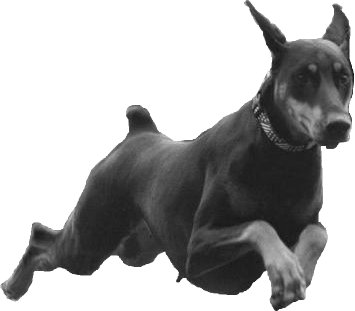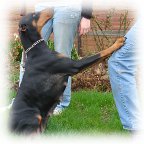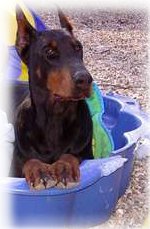What you need to know before purchasing a Doberman Pinscher
Do you want a Doberman Pinscher as a guard dog or as a family pet?
Temperaments vary considerably, so make sure you understand what you want and be sure to meet both parents. The Doberman Pinscher is a very energetic, alert, fearless, and watchful dog. The Dobie needs a secure fence and lots of room to run and exercise. Dobermans are especially happy when they have another medium or large sized dog they can run and play with.
Because of their reputation for aggression, even friendly ones need to be well-controlled at all times in public. Firm-handed socialization and obedience training are critical for all Doberman Pinschers.
History of the Breed
The Doberman traces its roots to 19th Century Germany, where it was developed as a police dog by Herr Louis Dobermann- a police officer and tax collector. The man required a loyal, obedient and fiercely protective dog to accompany him on his nightly rounds. Since he also worked as the keeper of the local animal shelter, he had a continuous supply of breeding stock to help him develop just such an animal.
Some of the breeds used to shape the Dobie include the German Pinscher, Rottweiler and German Shorthaired Pointer. The resulting dog possessed an uncanny intelligence, bravery, loyalty, stamina, and protectiveness, and was easy to care for. It was with great pride that this breed became known as "Dobermann's Pinscher."
After Dobermann died in 1894, his protégé, Otto Goeller, continued his mentor's plans and is credited by many as the true architect of the breed. Goeller organized the National Dobermann Pinscher Club in Germany in 1899. Shortly thereafter he and his committee members wrote the first breed standard.
By 1890, the Doberman was born and by 1900 the breed was officially recognized. Soon the breed was imported to the United States. By 1921, the Doberman Pinscher Club of America was founded and the dog quickly gained popularity as a working breed.
Today's Doberman Pinscher lost the second 'n' from its name and has mellowed in fierceness to become a family member capable of displaying great gentleness and devotion to children and other animals in the home. Having left behind his terrier roots, he has also dropped the Pinscher portion of the name in many countries.
Description of the Dog
 The Doberman is a very muscular and powerful dog that has many elegant features. The dog is well proportioned, compact, has a muscular neck, lean body, and an unmistakeable air of aristocracy, nobility and elegance.
The Doberman is a very muscular and powerful dog that has many elegant features. The dog is well proportioned, compact, has a muscular neck, lean body, and an unmistakeable air of aristocracy, nobility and elegance.
The ideal Doberman head is wedge-shaped with eyes blending in with the color of the coat. Dark eyes are much preferred over other shades and should be relatively deep set. A Doberman's expression should display his great intelligence and vigorous character.
The dog's ears may be cropped, though cropping is illegal in many countries including Great Britain and Australia but many others, including American Doberman fanciers, believe that an erect, cropped ear enhances the appearance of this breed. The dog's tail is usually docked at birth at approximately the second joint of the spine.
Coat
The short, gleaming coat is typically black with rust markings or red with lighter rust markings. Less common, but also acceptable in the breed, are blue and fawn (Isabella) with lighter markings.
The rust markings should appear on the muzzle, the throat, above the eyes, the front of the chest, beneath the tail and on all legs and feet. A small white patch less than one-half inch square is permissible on the chest but no other white is allowed. White Dobermans may not be shown, as this is a disqualifying fault.
Height
Male: 26 and 28 inches at the shoulder Female: 24 to 26 inches at the shoulder.
Weight
The weight of an adult dog will typically range between 60 and 85 pounds depending on size and sex.
Personality
Temperament of the Dog
Originally bred to be a fierce dog, the breed's temperament has toned down over the years and the dog is now a loving and devoted family pet. The breed is known to be bold, alert and loyal with a strong desire to please.
Its innate guarding instinct makes it a good watchdog. Despite being loyal and protective, if improperly bred or raised, the breed can be mean or aggressive.
The Doberman is intelligent and can be domineering and it is not unusual for this breed to produce one-man and one-family dogs because of their great loyalty.
The Doberman must have constant human companionship and social interaction, not only with its owner but also with all kinds of people and other dogs. This is essential to the well being of the breed.
Indoor or outdoor lifestyle?
This breed enjoys both an indoor and outdoor lifestyle, and does not like to be abandoned in the backyard or away from its family.  The Doberman is very sensitive to cold as they have very thin hair and should not be left outside in the cold or overnight. As long as the dog is well exercised, it can adapt well to living in an apartment.
The Doberman is very sensitive to cold as they have very thin hair and should not be left outside in the cold or overnight. As long as the dog is well exercised, it can adapt well to living in an apartment.
Dobies are a medium- to large dogs with exemplary intelligence and a high prey drive, which can make them a formidable breed for the first time dog owner.
What about kids?
A well-socialised Doberman is capable of displaying gentleness and devotion to children and other animals in the home. Both puppy and children should be taught to respect each other from the start.  Despite being loyal and protective, if improperly bred or raised, the breed can be mean or aggressive and is not a good choice for first time owners or families with toddlers who could get hurt by the dog's bulk.
Despite being loyal and protective, if improperly bred or raised, the breed can be mean or aggressive and is not a good choice for first time owners or families with toddlers who could get hurt by the dog's bulk.
They can be very good with other dogs, especially if they all are of good temperament. Aggression towards other dogs is accepted in the AKC breed standard.
How to take care of the Doberman Puppies
A well-socialised Dobermann is capable of displaying gentleness and devotion to children and other animals in the home. Both puppy and children should be taught to respect each other from the start.
Despite being loyal and protective, if improperly bred or raised, the breed can be mean or aggressive and is not a good choice for first time owners or families with toddlers who could get hurt by the dog's bulk.
They can be very good with other dogs, especially if they all are of good temperament.
Training
Highly intelligent, these dogs are quick to learn and enjoy mental stimulation. An energetic and versatile breed, the dog excels in canine sports from obedience to agility. This breed is full of quick learners and training should be undertaken as soon as possible to control its assertive nature. The Doberman can display undesirable behaviours if it is deprived of exercise and training.
Doberman owners must accept from the beginning that Dobermans can be mischievous - they can cause damage to your house and garden, and they can be noisy. If you are particularly house-proud and can't bear the thought of a dog making a mess, then this breed is not for you.
A well-trained and obedient Doberman is, nevertheless, a joy to watch, and the breed is used by police forces in various countries.
Activity Level
Exercise Needs
Exercise is critical for the health and well being of the dogs. They were bred and born to work and have a great deal of energy to burn. Most Dobermans require about an hour of exercise a day to keep fit. Long walks and frequent play sessions in secure areas will make your dog fit and keep him from becoming nervous. Other exercise alternatives can include playing fetch, swimming or hurdle jumping. The Doberman that is given plenty of opportunity to exercise is a much happier and healthier dog.
Health and Care
Genetic Problems
Overall, the breed is healthy but can be prone to a few disorders including, Von Willebrand's disease (a bleeding disorder), Wobbler syndrome (disease of the spinal column), gastric torsion (a life-threatening sudden illness associated with the stomach filling with air and twisting), skin diseases, hip dysplasia and dilated cardiomyopathy.
Litter Size: 3 to 5 pups.
Life Span: 10 to 12 years.
